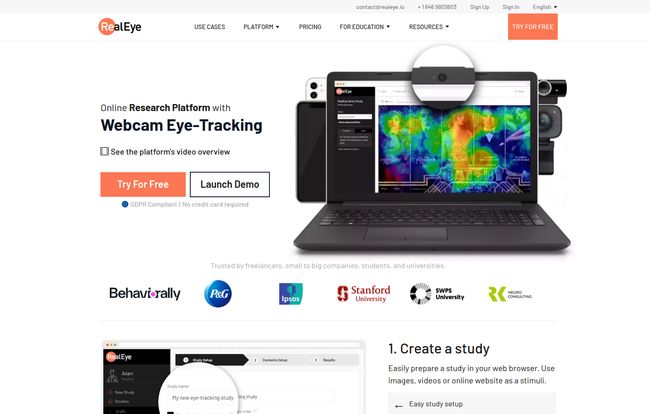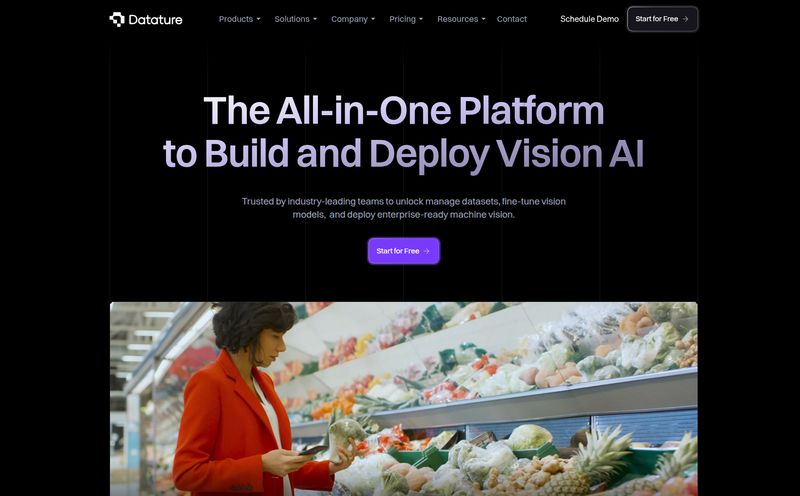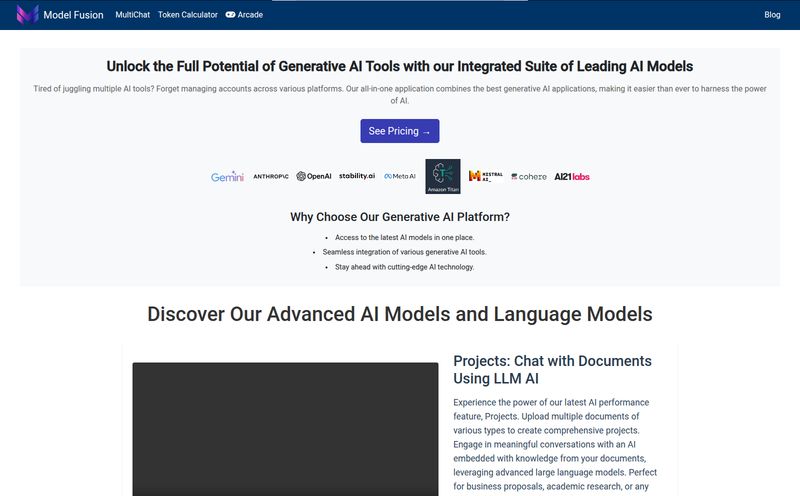I’ve been in the SEO and digital marketing world for what feels like an eternity. I’ve seen fads come and go, from keyword stuffing monstrosities to the promise of AI taking over everything (still waiting on that one). So when a tool comes along promising to deliver lab-grade eye-tracking insights using nothing but a user’s webcam, my professional skepticism-o-meter goes through the roof. It just sounds too good to be true.
Traditional eye-tracking? It's a whole thing. You need a dedicated lab, expensive infrared hardware, and participants you’ve probably bribed with pizza and gift cards to sit in a sterile room. It's powerful, sure, but it's also slow, costly, and about as natural as a zoo enclosure.
Then I stumbled across RealEye.io. The claim is simple: get powerful attention and emotion analysis from remote particpants, all through their web browser. No lab. No fancy gear. My first thought was, “Yeah, right.” But the list of clients—Stanford, Ipsos, Behaviorally—made me pause. These guys don’t mess around. So, I decided to take a closer look. And honestly? I'm pretty impressed.
So, What is This RealEye Thing Anyway?
At its core, RealEye.io is an online research platform that turns a standard webcam into an eye-tracking device. You design a study—maybe you want to test a new website layout, a video ad, or a piece of packaging—and send a link to your participants. As they look at your content, RealEye’s algorithm tracks their gaze, translating that data into heatmaps, gaze plots, and other juicy analytics. It’s like getting a secret window into what your audience actually sees, not just what they say they see in a follow-up survey.
This isn't just about where the eyes go, either. The platform also offers facial coding to analyze emotional responses. Did that joke in your ad land, or just confuse people? Are users getting frustrated with your checkout process? This adds a layer of qualitative emotional data that is, frankly, gold for any marketer or UX designer.
<

Visit RealEye.io
#>
The Features That Genuinely Caught My Eye
You can read a feature list anywhere. Let's talk about what actually moves the needle in a real-world project.
Webcam Eye-Tracking and Those Gorgeous Heatmaps
This is the main event. The ability to generate heatmaps and gaze plots without specialized hardware is the killer feature. For anyone who’s ever tried to justify a design decision in a meeting, showing a heatmap where everyone’s attention is focused on the wrong part of the page is infinitely more powerful than saying, “Well, my gut says the CTA should be here.” You get to see the user's journey, the blind spots on your page, and the elements that grab immediate attention. It’s visual, it's undeniable, and it cuts through so much corporate fluff.
Reading the Room with Emotion Analysis
The facial coding is what takes RealEye from a cool tech demo to a serious research tool. Using the webcam, it analyzes micro-expressions to gauge emotions like happiness, surprise, confusion, and disgust. Imagine A/B testing two different ad creatives and not just seeing which one gets more clicks, but which one elicits more joy. That’s a whole different level of insight. It’s the closest many of us will get to true data-driven empathy.
The Practical Stuff: Dashboards and Integrations
A tool is only as good as its workflow. I was relieved to see that RealEye plays nice with others. You can integrate it with popular survey platforms and panel providers. The study dashboard itself is clean, letting you manage multiple projects, see results in real-time, and export the data (as CSV on the Standard plan) for further number-crunching in Excel or SPSS. They also offer their own pool of participants, the “RealEye Panelists,” which is handy if you need to get a study off the ground quickly without your own list.
<
#>
Can a Webcam Really Replace a Professional Lab?
Okay, let's have a real talk. Is the data from a 720p webcam in someone's dimly lit bedroom as precise as a $20,000 Tobii eye-tracker in a controlled lab? No. Of course not. And RealEye is upfront about this. The accuracy is dependent on the participant's webcam quality, their lighting, and them sitting still during the initial calibration.
But here’s my take: this is the wrong question to ask. It's like asking if a pro-grade smartphone camera can replace a RED cinema camera. They're for different things. The value of RealEye isn’t in its sub-millimeter precision; it’s in its speed, scale, and accessibility.
You can test 100 people across three continents in an afternoon for a fraction of the cost of bringing 10 people into a lab. You get data from users in their natural environment—their chaotic home office, their couch—which is arguably more representative of real-world usage than a sterile lab. For most marketing and UX questions, the directional accuracy and speed of RealEye are more than enough. It's about getting solid, actionable insights quickly, not publishing a paper in a scientific journal. I've always felt that good-enough data today is better than perfect data next month.
<
#>
Let's Talk Money: The RealEye.io Pricing Plans
Pricing is always the elephant in the room, so let's get it out there. RealEye operates on a subscription model, and the plans are pretty clearly defined for different types of users.
| Plan | Price | Best For | Key Features |
|---|---|---|---|
| Basic | $249 /month | Quick, short tests | Unlimited studies, 10-min max study time, Facial Coding, Smartphone data. |
| Standard (Popular) | $690 /month | Regular, in-depth studies | Adds Survey Module, 3rd party panel integration, CSV data export, Team Collaboration. |
| Custom | Get a Quote | Agencies & high-volume users | Adds API access, unlimited test subjects, training, and more. |
Note: These prices were accurate at the time of writing, but you should always check their official pricing page for the latest info.
For a freelancer or a small business just dipping their toes in, the Basic plan is a great starting point to test a few key assets. For agencies or in-house UX teams, the Standard plan seems like the sweet spot. The ability to export data and collaborate with team members is crucial for any serious, ongoing research effort.
<
#>
So, What's the Verdict?
After digging in, my initial skepticism has softened into cautious optimism. RealEye.io isn't a magic wand. It's a tool, and like any tool, its effectiveness depends on the user. You still need to design a good study and understand the platform's limitations.
But is it a game-changer? For many of us, I think so. It democratizes a form of user research that was previously locked away in expensive labs. It lowers the barrier to entry for getting real, visual data on user attention. It allows for rapid, iterative testing in a way that traditional methods just can’t match. It might not have the absolute precision of lab equipment, but it makes up for it with real-world context, speed, and scale. For that, it’s earned a spot in my digital marketing toolbox.
Frequently Asked Questions
How accurate is the webcam eye-tracking?
It's surprisingly good for directional insights. RealEye themselves claim accuracy within about 1-2 cm on a typical screen. It's perfect for knowing if users saw your CTA, but maybe not for analyzing tiny text. The quality depends heavily on the participant's setup (good webcam, good lighting).
What do participants need to take part?
Just a computer with a webcam and a modern web browser like Chrome or Firefox. It's a very low barrier, which is great for recruitment. No software installation is needed.
Can I use my own panel of users?
Absolutely. You can just send your own participants a study link. This is often the most cost-effective way to use the platform if you have an existing email list or user panel.
What's the difference between using my own users vs. RealEye panelists?
Using your own users is cheaper and ensures they match your target demographic. RealEye panelists are great for speed and convenience when you need general population data quickly, but they come at an additional cost and have some restrictions on study length.
Is it difficult to set up a study?
Not at all. The interface is pretty intuitive. If you can build a simple survey in Google Forms, you can build a study in RealEye. You upload your images or provide URLs, write your instructions, and you're pretty much ready to go.
Is there a free trial?
Yes, they have a "Try For Free" option on their site. It's a great way to get a feel for the platform's interface and capabilities before committing to a paid plan.


